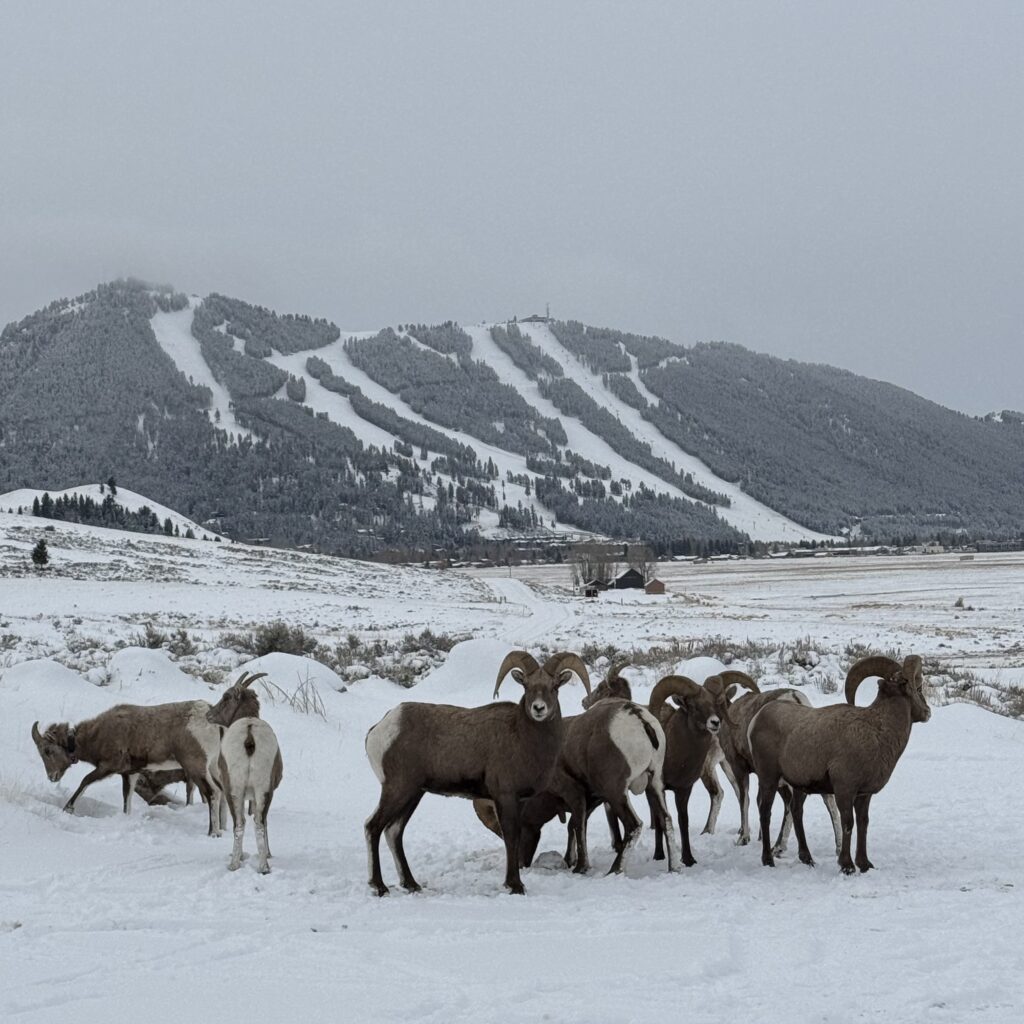The Big Horns of Bighorn Sheep
Bighorn sheep are one of 8 ungulate species in Grand Teton National Park. Unlike elk, moose, and deer, which have antlers, bighorn sheep have horns. Both male and female sheep grow horns; however, female sheep’s horns are shorter and don’t grow much after 4-5 years. Ram (male sheep) horns grow significantly until the individual is fully mature, at which point growth slows but does not cease. You can age a ram by looking for ‘growth rings’, which look like dark bands on his horns. These rings correspond with mating seasons (for Rocky Mountain bighorns, in the winter in December), which are times of stress on ram’s bodies. Rams establish dominance and gain mating privileges through head-butting, and therefore must be able to withstand up to several hours of head-on collisions. Above the brain, their skulls have air spaces above “that function as a shock absorber” (NPS). Their horns’ spiral geometry and core of honeycomb-like bone architecture, also full of air spaces, help absorb energy from these head-butting impacts and are being studied for their potential use in ‘bioinspired materials’ for injury prevention (Drake et al.). Additionally, it is theorized that “rams take in a deep breath prior to clashing their horns, adding oxygen to their blood and expanding the blood volume in their head. Bighorn sheep have additional adaptations that slow the return of blood so the brain can settle within the skull before the oxygen returns to normal levels. These anatomical modifications reduce the chance for rams to sustain brain injuries.” (Estes Park Trail Gazette).
Bighorn Sheep Herds Around Jackson Hole
Combined aerial surveys and DNA analysis estimate the population of the Teton Range bighorn sheep herd at between 100-175 sheep. According to the NPS, an ideal population has at least 300 sheep to “increase the probability of long-term persistence with minimal loss of genetic diversity.” While aerial surveys don’t represent a full census of the bighorn sheep population, they are helpful in tracking population trends. The park service also believes that the severe 2023 winter caused a population decline in the Teton population.
Meanwhile, the Jackson herd that summers in the Gros Ventre Mountains is estimated at over 500 sheep, a number that biologists say is close to the habitat’s carrying capacity and may contribute to disease outbreaks (like pneumonia) and die-off (KHOL). In early December 2024, Bridger Teton National Forest, Wyoming Game and Fish, and University of Wyoming biologists and techs collaborated to capture and collect data on Jackson herd sheep. Our biologist guides had the opportunity to observe this process during our staff training. This effort is part of an “ongoing study designed to learn why and how [an ‘all-ages die-off’] might be prevented” (Buckrail). One prevention method is increasing the habitat carrying capacity, i.e. increasing the number of sheep that can live in the area. This can be achieved through long-term efforts like invasive plant control, prescribed burns, and mowing sagebrush. (Buckrail).
Teton Mountains Herd Conservation Issues
The Teton Mountains bighorn sheep herd faces several conservation issues:
- Migratory route disruption: Human development in the Jackson area has permanently blocked this herd’s access to its original migration route and lower-elevation winter range.
- Habitat loss: Fire suppression efforts have both blocked access to and lowered the quality of local habitat, and winter recreationists (e.g. backcountry skiers) have displaced the Teton herd from an estimated 30% of their original winter range. Sharing winter habitat with humans causes sheep to move frequently and burn more energy, which may negatively impact their reproduction or lead to starvation.
- Increasing population of mountain goats: While bighorn sheep are considered a native species and have inhabited this area for thousands of years, mountain goats were introduced into Idaho’s Snake River Range for hunting purposes. The mountain goat population expanded into the Tetons in the 1960s – 1970s, carrying with it bacterial diseases lethal to bighorn sheep and posing competition for resources. Grand Teton National Park began mountain goat removal efforts in 2020, with methods including using professional sharpshooters in helicopters. As of March 2024, the NPS estimates 10-20 goats are present in the Teton Range. Additionally, “the Wyoming Legislature passed legislation that allowed for a new type of mountain goat license, and the Wyoming Game and Fish Department and Wyoming Game and Fish Commission created a new mountain goat hunting season outside of [Grand Teton National] park with the goal of completely removing mountain goats from the Teton Range.” (Teton Bighorn Sheep Working Group).
Winter Wildlife Closures
If you are visiting Jackson Hole for the first time, you may have never heard of a Winter Wildlife Closure. These closures aim to protect the winter range of local wildlife by closing key areas to human use between December 1st and April 30th each year. “Winter range is the land, topography, and habitat that big game species (deer, elk, moose, bighorn sheep) require to survive deep snow, frigid temperatures, predation threats, and stress from human causes.” (Teton Conservation District). While an animal may stand still when approached by winter recreationists or hears unfamiliar sounds, its heart rate likely still increases, and it uses more energy.
The Teton Conservation District has created an unofficial Winter Wildlife Area Map for areas administered by the Bridger-Teton and Caribou-Targhee National Forests, Grand Teton National Park, National Elk Refuge, and Wyoming Game and Fish Department. In addition, Grand Teton National Park has an interactive map (for areas inside the park) with both wildlife closure areas, which are closed to humans, and bighorn sheep winter zones, which backcountry recreationists are urged to voluntarily avoid in order to help protect the local bighorn sheep population.
Peep the Sheep
We encourage our guests, and everyone visiting the Jackson Hole area, to be good stewards. The incredible animals that call these mountains and valley home are one of the reasons Jackson is so special, and why millions of people are excited to come here! If you’re exploring on your own, be sure to respect the wildlife closures and local rules that are in place to protect bighorn sheep and other wildlife. For example, on the National Elk Refuge, don’t stop your vehicle on the road, and don’t let the sheep lick your car – this can spread diseases like pneumonia and put the herd at further risk. Not sure where to go? Wildlife Expeditions’ passionate and knowledgeable guides have trained eyes for spotting wildlife and will help you start the day viewing local fauna in the quiet, dawn hours when wildlife like bighorn sheep are most active.
Sources:
https://www.nps.gov/yell/learn/upload/8_RI_2024_Wildlife.pdf
https://buckrail.com/gtnp-mountain-goat-management-ongoing-bighorns-likely-declined-in-2023/
https://www.tetonconservation.org/winter-wildlife-closures
https://www.sciencedirect.com/science/article/abs/pii/S1742706116304159
Aaron Drake, Tammy L. Haut Donahue, Mitchel Stansloski, Karen Fox, Benjamin B. Wheatley, Seth W. Donahue, Horn and horn core trabecular bone of bighorn sheep rams absorbs impact energy and reduces brain cavity accelerations during high impact ramming of the skull, Acta Biomaterialia, Volume 44, 2016, Pages 41-50, ISSN 1742-7061, https://doi.org/10.1016/j.actbio.2016.08.019. (https://www.sciencedirect.com/science/article/pii/S1742706116304159)
https://891khol.org/facing-a-die-off-bighorn-sheep-get-airlifted-for-a-health-checkup/
https://www.eptrail.com/2022/11/22/nature-nuggets-science-behind-bighorn-ram-head-butting/
https://buckrail.com/jackson-bighorn-sheep-herd-may-be-heading-towards-an-all-ages-die-off/


